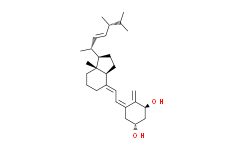| Cas No.: | 54573-75-0 |
| Chemical Name: | Vitamin D2, 1a-Hydroxy- |
| Synonyms: | Vitamin D2, 1a-Hydroxy-;1α-hydroxyergocalciferol (Ercalcidol);1ALPHA-OH-D2;1-alpha-hydroxyergocalciferol;1alpha-hydroxyergocalciferol;1-alpha-hydroxyvitamind2;1-hydroxyergocalciferol;7,10(19),22-tetraene-1,3-diol,(1-alpha,3-beta,5z,7e,22e)-10-secoergosta-5;VITAMIN D2, 1ALPHA-HYDROXY-;25-HYDROXYERGOCALCIFEROL;Doxercalciferol;(1R,3S,E)-5-((E)-2-((1R,3AS,7aR)-1-((2R,5S,E)-5,6-dimethylhept-3-en-2-yl)-7a-methyldihydro-1H-inden-4(2H,5H,6H,7H,7aH)-ylidene)ethylidene)-4-methylenecyclohexa;1.alpha.-Hydroxyvitamin D2;1-hydroxy Vitamin D2;Doxecalciferol;(5Z,7E,22E)-9,10-Secoergosta-5,7,10(19),22-tetraene-1α,3β-diol;(5Z,7E,22E)-9,10-Secoergosta-5,7,10(19),22-tetraene-1,3-diol;1α-Hydroxyergocalciferol;1α-Hydroxyvitamin D2;1α-OHD2;1-α-Hydroxyvitamin D2;1-Hydroxyergocalciferol;TSA 840;(5Z,7E,22E)-9,10-Secoergosta-5,7,10,22-tetraene-1,3-diol;(1R,3S,5Z)-5-[(2E)-2-[(1R,3aS,7aR)-1-[(E,2R,5R)-5,6-Dimethylhept-3-en-2-yl]-7a-methyl-2,3,3a,5,6,7-hexahydro-1H-inden-4-ylidene]ethylidene]-4-methylidenecyclohexane-1,3-diol;1α-Hydroxy Vitamin D2 |
| SMILES: | CC([C@H](/C=C/[C@H]([C@H]1CC[C@H]2/C(=C/C=C3/C[C@@H](O)C[C@H](O)C/3=C)/CCC[C@]12C)C)C)C |
| Formula: | C28H44O2 |
| M.Wt: | 412.647768974304 |
| Purity: | >99% |
| Sotrage: | 2 years -20°C Powder, 2 weeks 4°C in DMSO, 6 months -80°C in DMSO |
| Description: | Doxercalciferol is a Vitamin D2 analog, acts as an activator of Vitamin D receptor, and prevent renal disease. |
| Target: | Vitamin D receptor[1] |
| In Vivo: | Doxercalciferol (0.083, 0.167 or 0.333 μg/kg, i.p.) elevates serum phosphorus at Week 6 in 5/6 nephrectomized (NX) rats. Doxercalciferol (0.167 and 0.333 μg/kg) also increases serum calcium and Ca × P at Weeks 2 and 6, and enhances increased pulse wave velocity (PWV) at Week 6 in 5/6 nephrectomized (NX) rats. Doxercalciferol blocks PTH from rising at 0.083 μg/kg, and lowers serum PTH to the SHAM level[1]. Doxercalciferol (125 ng/kg, i.p. thrice per week) increases expression of VDR mRNA level and renal expression of TRPV5 in NON mice fed a HF diet. Doxercalciferol also improves proteinuria, prevents loss of podocytes, and accumulation of extracellular matrix proteins in HF diet-induced mice. Doxercalciferol inhibits the expression of profibrotic growth factors (TGF-β, PAI-1, and connective tissue growth factor (CTGF)), and blocks increased expression of the renin-angiotensin-aldosterone system in mice fed a HF diet. Furthermore, Doxercalciferol suppresses macrophage infiltration, decreases NF-κb activity, and preventes expression of proinflammatory cytokine and the increase in renal lipid accumulation in mice fed a HF diet[2]. Doxercalciferol (30 ng/kg, i.p. thrice per week) prevents albuminuria, markedly attenuates podocyte loss and apoptosis, and reduces glomerular fibrosis in streptozotocin-induced diabetic mice[3]. |
| Animal Administration: | Rats[1] Male, Sprague-Dawley, 5/6 nephrectomized (NX) rats (∼200 gm) are used 1 week after nephrectomy. The nephrectomy is performed using a standard two-step surgical ablation procedure. Beginning 2 weeks post-nephrectomy, rats are maintained on a high phosphorus diet (0.9% phosphorus and 0.6% calcium) for the duration of the study to induce secondary hyperparathyroidism. On Day 0, SHAM and 5/6 NX rats (n = 7-10 per group) receive vehicle (5% EtOH/95% propylene glycol; 0.4 mL/kg; i.p.) or VDRA (paricalcitol or Doxercalciferol; 0.083, 0.167 or 0.333 μg/kg; intraperitoneally) three times per week for 41 days (n = 6-10 per group). These doses are chosen based on the fact that lower doses (0.021 and 0.042 μg/kg; i.p.) of either compound are not PTH suppressive after 2 or 6 weeks of treatment in this model of CKD. On Days 0, 13 and 41, blood is collected (24 h post-dose). On Days 0, 13 and 41 (24 h post-dose), animals are anaesthetized with ketamine (50 mg/kg) and blood is collected via the tail vein for PTH and serum blood chemistry determinations[1]. |
| References: | [1]. Noonan W, et al. Differential effects of vitamin D receptor activators on aortic calcification and pulse wave velocity in uraemic rats. Nephrol Dial Transplant. 2008 Dec;23(12):3824-30. [2]. Wang XX, et al. Vitamin D receptor agonist doxercalciferol modulates dietary fat-induced renal disease and renal lipid metabolism. Am J Physiol Renal Physiol. 2011 Mar;300(3):F801-10. [3]. Wang Y, et al. Vitamin D receptor signaling in podocytes protects against diabetic nephropathy. J Am Soc Nephrol. 2012 Dec;23(12):1977-86. |

 DC Chemicals' products qualify for U.S. tariff exemptions. We guarantee no price increases due to customs duties and maintain stable supply, continuing to deliver reliable research solutions to our American clients.
DC Chemicals' products qualify for U.S. tariff exemptions. We guarantee no price increases due to customs duties and maintain stable supply, continuing to deliver reliable research solutions to our American clients.





















